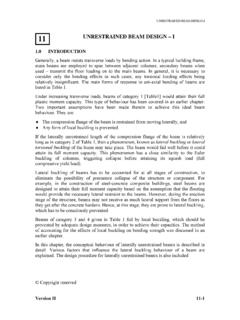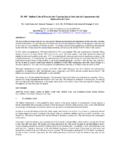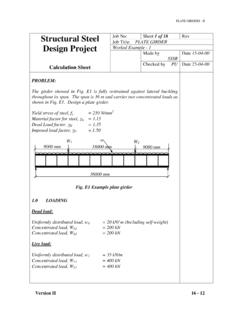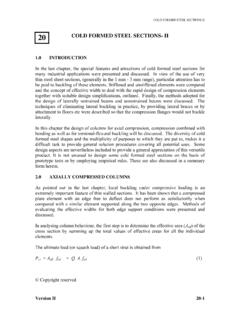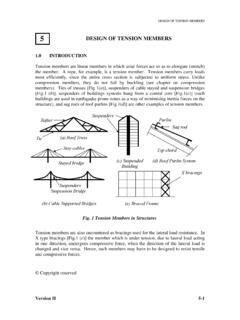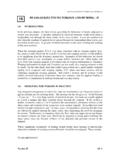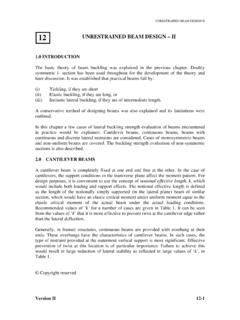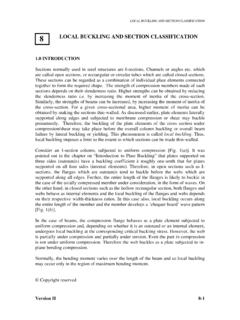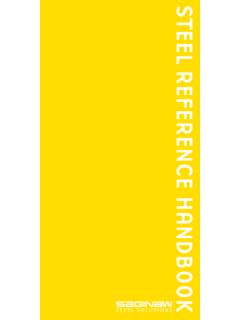Transcription of STEEL BEAMS WITH WEB OPENINGS
1 STEEL BEAMS with WEB OPENINGS Version II 28 - 1 STEEL BEAMS with WEB OPENINGS INTRODUCTION The responsibility of a Structural Engineer lies in not merely designing the structure based on safety and serviceability considerations but he also has to consider the functional requirements based on the use to which the structure is intended. While designing a power plant structure or a multi-storeyed building, the traditional structural STEEL framing consists of BEAMS and girders with solid webs. These hinder the provision of pipelines and air conditioning ducts required for satisfactory functioning for which the structure is put up. Very often, the service engineer who is on the scene long after the structural erection has been completed is required to fix air conditioning ducts in place.
2 The re-routing of services (or increasing the floor height at the design stage for accommodating them) leads to additional cost and is generally unacceptable. The provision of BEAMS with web OPENINGS has become an acceptable engineering practice, and eliminates the probability of a service engineer cutting holes subsequently in inappropriate locations. BEAMS with web OPENINGS can be competitive in such cases, even though other alternatives to solid web BEAMS such as stub girders, trusses etc are available. This form of construction maintains a smaller construction depth with placement of services within the girder depth, at the most appropriate locations. The introduction of an opening in the web of the beam alters the stress distribution within the member and also influences its collapse behaviour.
3 Thus, the efficient design of BEAMS and plate girder sections with web OPENINGS has become one of the important considerations in modern structures. In this chapter, methods to evaluate the ultimate shear capacity of the BEAMS and fabricated girders with circular or rectangular web OPENINGS are discussed. The methodology is based on the Von Mises yield criterion. GUIDELINES FOR WEB OPENINGS AND STIFFENERS The shape of the web OPENINGS will depend upon the designer's choice and the purpose of the opening . There are no hard and fast rules to dictate the shapes of the OPENINGS . But, for designer's convenience, OPENINGS of regular shapes (such as circular or rectangular) are usually chosen. Introduction of OPENINGS in the web decreases stiffness of the BEAMS resulting in larger deflections than the corresponding BEAMS with solid webs.
4 The strength of the BEAMS with OPENINGS may be governed by the plastic deformations that occur due to both moment and shear at the OPENINGS . Copyright reserved i. exe 28 STEEL BEAMS with WEB OPENINGS Version II 28 - 2 The strength realised will depend on the interaction between the moment and shear. The moment capacity of the perforated beam will be reduced at the opening because of the reduction in the contribution of web to the moment capacity. This is not very significant, as usually the contribution of the web to the moment capacity is very small. However, the reduction in shear capacity at the opening can be significant. Therefore the ultimate capacity under the action of moment and shear at the cross section where there is an opening will be less compared to that at the a normal cross section without opening .
5 Some strength is lost. To restore the strength lost, reinforcement along the periphery of the OPENINGS could be provided. As a general rule, we should avoid having OPENINGS in locations of high shear, nor should they be closely spaced. Common types of web OPENINGS with and without reinforcement are shown in Fig. 1. The following general design guidelines may be useful [Fig. 2 (a)]. Common types of web OPENINGS (d) Web with centrally placed circular hole with reinforcement (c) Web with centrally placed rectangular hole with reinforcement (b) Web with centrally placed circular hole (e) Castellated BEAMS (b) Web with centrally placed rectangular hole STEEL BEAMS with WEB OPENINGS Version II 28 - 3 x The hole should be centrally placed in the web and eccentricity of the opening is avoided as far as possible.
6 X Unstiffened OPENINGS are not always appropriate, unless they are located in low shear and low bending moment regions. x Web opening should be away from the support by at least twice the beam depth, D or 10% of the span ("), whichever is greater x The best location for the opening is within the middle third of the span. x Clear Spacing between the OPENINGS should not be less than beam depth, D. d 2D Fig. 2 Guide lines for web holes and various stiffening arrangements (c) Various stiffening arrangements Flange Web Stiffener opening opening opening D d t 2D or " (a) Stiffened opening D d t 2D or " d (b) Un-Stiffened opening " " STEEL BEAMS with WEB OPENINGS Version II 28 - 4x The best location for opening is where the shear force is the lowest. x The diameter of circular OPENINGS is generally restricted to x Depth of rectangular OPENINGS should not be greater than and the length not greater than for un-stiffened OPENINGS .
7 The clear spacing between such opening should be at least equal the longer dimension of the opening . x The depth of the rectangular OPENINGS should not be greater than and the length not greater than 2D for stiffened OPENINGS . The above rule regarding spacing applies. x Corners of rectangular OPENINGS should be rounded x Point loads should not be applied at less than D from side of the adjacent opening . x If stiffeners are provided at the OPENINGS , the length of the welds should be sufficient to develop the full strength of the stiffener. Various types of stiffeners are shown in Fig. 2(c). x If the above rules are followed, the additional deflection due to each opening may be taken as 3% of the mid-span deflection of the beam without the opening . FORCE DISTRIBUTION AND FAILURE PATTERN AT WEB OPENINGS BEAMS with perforated thick webs In buildings, the depth to thickness ratio of the beam web is kept low (below 80).
8 Such webs are not prone to local buckling in shear and are termed thick webs . On the other hand, in bridge structures the girder depths adopted are generally large and hence the plate girders are characterised by web slenderness ratios above 80. The behaviour of these plate girders has been elaborately discussed by Narayanan (4) and is not discussed here. However in building floor construction, stockier webs having slenderness ratio of 50 to 80 are more common and the discussion in the section is restricted to such BEAMS with OPENINGS . Mathematical models for the design of thick webs containing OPENINGS have been developed by Redwood and his colleagues based on the plastic analysis of structures and is described below.
9 Basis of Analysis A single rectangular opening in a traditional beam used in buildings is considered first [See Fig. 3(a)]. The hole is located a little bit above the Neutral axis for illustration. The hole may (or may not) be reinforced. Fig. 3(a) Rectangular Hole in the web Centroidal axis of the beam dh Centroidal axis of the hole STEEL BEAMS with WEB OPENINGS Version II 28 - 5 The web of the beam is thick and is not prone to buckling in shear under the action of the loads, the collapse is likely to be initiated by the formation of four plastic hinges, near the four corners of the hole in the web above and below the OPENINGS . Note the location of four plastic hinges in Fig. 3(b). This is due to behaviour of the beam as a virendeel girder.
10 Force distribution and failure pattern The forces acting at the ends of a rectangular opening are shown in the Fig. 4(a). For thick webs with a circular opening , Redwood proposed an equivalent effective size of rectangular opening as shown in Fig. 4(b). Note that R represents the radius of circular opening in Fig. 4(b). It is seen that the overall bending moment M is resisted by the compression T2 in the top web plate, and tension T1 in the bottom web plate forming a couple (T1 = T2 for equilibrium) acting at distance h apart, together with relatively small moments Mt1 and Mb1 acting in the top and bottom portions of the opening . These moments Mt1 and Mb1 are generated because of vierendeel action and hence called vierendeel moments.
